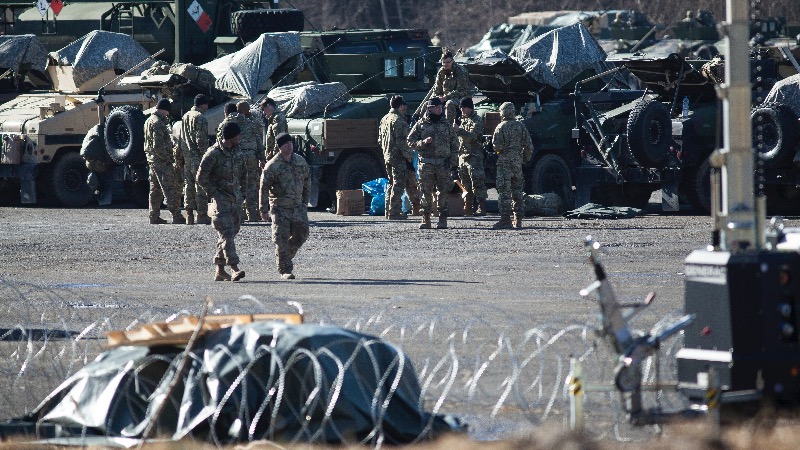 Image Credit: NurPhoto / Contributor / Getty
Image Credit: NurPhoto / Contributor / Getty Washington is pulling some of its military forces out of Eastern Europe as it switches focus to Asia.
On Wednesday The Department of War issued a press release describing the geographic pivot:
As part of the Secretary of War’s deliberate process to ensure a balanced U.S. military force posture, the 2nd Infantry Brigade Combat Team of the 101st Airborne Division will redeploy as scheduled to their Kentucky-based home unit without replacement.
This is not an American withdrawal from Europe or a signal of lessened commitment to NATO and Article 5. Rather this is a positive sign of increased European capability and responsibility. Our NATO allies are meeting President Trump’s call to take primary responsibility for the conventional defense of Europe. This force posture adjustment will not change the security environment in Europe.
The U.S. maintains a robust presence throughout the European Theater, and maintains the ability to array forces and capabilities to meet objectives in the Theater and support U.S. priorities, including President Trump’s commitment to defend NATO allies.
While the press release appears to focus on reassuring Europe that America is still there to defend it, albeit with less manpower, the geopolitical significance of the move should not be understated. With China gaining stake in South America, Washington’s Asia-pivot may be based more in-line with the Monroe Doctrine than a new never-ending war NeoCon doctrine.
The globalist think tank The Council on Foreign Relations described China’s growing influence in South America:
- China is South America’s top trading partner and a major source of both foreign direct investment and energy and infrastructure lending, including through its massive Belt and Road Initiative.
- Beijing has invested heavily in Latin America’s space sector and has strengthened its military ties with several countries, particularly Venezuela.
- Policymakers in Washington previously sought new trade and investment avenues to counter Beijing’s influence, but President Donald Trump has adopted a more assertive approach to the region in his second term.
The globalist think tank The Atlantic Council published an analysis on President Donald Trump’s Asia-pivot, which the authors explained is really a China-pivot. “This issue brief is part of the Scowcroft Center for Strategy and Security’s National Defense Strategy Project, outlining the priorities the Department of Defense should address in its next NDS.”
In the National Defense Strategy (NDS) of the first Donald Trump administration and that of the Joe Biden administration, great-power competition played a central role. However, both administrations considered China and Russia—and therefore the Indo-Pacific and Europe—as twin focal points of risk and strategic interest. The current Trump administration is shifting gears. Rather than balancing China and Russia, the Department of Defense (DoD) will now organize around China as the principal threat and competitor.
This prioritization is welcome. After all, defense planners have long criticized that trying to manage too many threats to the United States without a corresponding increase in defense budget makes it difficult to address any of them effectively. The problem is not whether the United States should engage globally—it must—but whether considering too many issues means that none of them are effectively prioritized.
But how can the Trump administration—through its upcoming NDS—successfully position China as the primary threat, while rebalancing its engagement in other regions in a measured and responsible way? The answer lies in updating the U.S. military’s force structure and rebalancing its force posture. Moreover, to deter China in the Indo-Pacific, the U.S. military should focus on long-range fires, the ability to move forces, the protection of critical defense infrastructure, and additional basing options.
In addition to Asia, military focus is also going back to the Western hemisphere, part of Trump’s adherence to The Monroe Doctrine.
“Defense Secretary Pete Hegseth looks to shift some of the American military’s focus toward domestic security, Latin America and Asia,” The New York Times said Wednesday.
Notably, talkshow host Nick Fuentes told Alex Jones on Wednesday how Trump should solely focus on the Western hemisphere, not Asia or Europe.
BREAKING EXCLUSIVE: Nick Fuentes Endorses The Monroe Doctrine & Supports Regime Change In Venezuela pic.twitter.com/6fMtAfUhQd
— Alex Jones (@RealAlexJones) October 29, 2025
The New York Times went on to say that the reduction of force consists of around 700 troops who were deployed in Germany, Romania and Poland in what’s referred to as NATO’s Eastern Flank. Specifically, the reduction is not a total withdrawal from the region, it will just reduce numbers from 1,700 to about 1,000 soldiers.
“Since taking office in January, Trump has made no secret of his desire to shift U.S. forces from Europe to the Pacific, and has repeatedly called on the leaders of NATO’s European allies to take more responsibility for the continent’s defense. However, the announcement of troop reductions in Romania will be alarming to many Eastern European countries, many of which have reason to fear possible Russian attacks,” The Baltic News Network said Wednesday.
Romania’s Minister of Defense Ionut Mosteanu also discussed this U.S. reduction of force:
“Romania and its allies were informed of the United States’ decision regarding the adjustment of American troops deployed in Europe on the Eastern Flank. Starting on Monday and Tuesday, we were officially informed, as Ministry, as Ministry of Foreign Affairs, our ambassador to NATO and the military attaché. This reassessment of posture is part of a broader strategy announced by the United States at the beginning of the year. The proposal is now before the US Congress. Messages have been conveyed over the past few months publicly, including two weeks ago at the NATO ministers’ meeting in Brussels, when the U.S. Secretary of Defense once again told European partners that Europe has strengthened its position on the Eastern Flank and, generally, across Europe, agreeing to arm itself better and pay more attention to its own defense. The United States will now focus more on the Indo-Pacific.”


